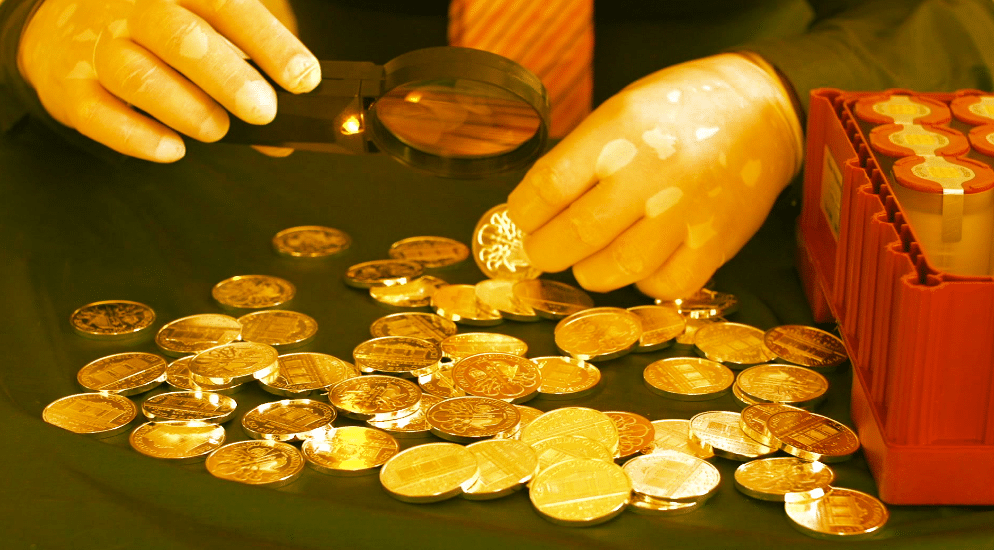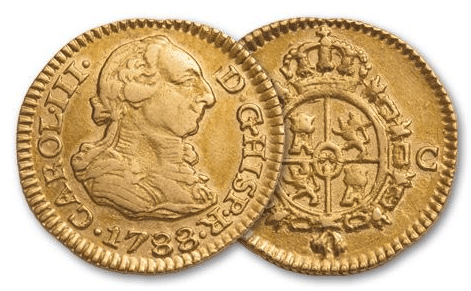What Denominations Do Gold Coins Come In

Gold coins come in a plethora of denominations that showcase the rich tapestry of history and artistry that you’ve come to love. From the initial gold dollar introduced in 1849, designed by James B. Longacre, to the larger and rare $50 pieces, each coin tells a unique story, blending cultural shifts and historical significance with innovation. We can broaden our knowledge of the various gold coin denominations by exploring the following:
- Early Gold Dollars
- Quarter Eagles Evolution
- Unique $3 and $4 Pieces
- Diverse Half Eagles
- High Denomination Gold Coins
You’ll encounter the $3 pieces minted between 1854 and 1889, designed explicitly for purchasing postage stamps, and the highly sought-after $4 ‘Stella’ coins minted in the late 1870s. Quarter Eagles and Half Eagles reflect American history through their evolving designs, while high denomination coins blend investment potential with collectible appeal, featuring heroes like the Liberty Head and Saint-Gaudens. Each piece, a testament to the U.S. Mint’s legacy of excellence, invites you to explore deeper into the allure of gold coins, uncovering stories of wealth, prestige, and innovation with each turn.

Early Gold Dollars
The U.S. Mint first introduced gold dollars in 1849, offering collectors a trio of distinctive designs: the Liberty Head, and both the small and large head variations of the Indian Princess. This era marked a pivotal moment in numismatic history, capturing the spirit of a burgeoning America on the brink of monumental change. You’re not just holding a piece of gold; you’re grasping a tangible piece of American history, a testament to the country’s growth and the evolving artistry of its coinage.
Diving into the details, the Liberty Head, designed by James B. Longacre, features Lady Liberty donning a coronet inscribed with “Liberty.” It’s a design that resonates with the principles of freedom and prosperity, making it highly sought after by collectors. Transitioning to the Indian Princess designs, the small and large heads offer a glimpse into the Mint’s experimentation with portraiture and symbolism. The small head variation, introduced shortly after the Liberty Head, and the large head, unveiled in 1856, showcase a unique representation of America’s native heritage, albeit through a romanticized lens.
What sets these gold dollars apart isn’t just their beauty or their gold content. It’s the stories they tell-of innovation, of cultural shifts, and of a nation’s journey through conflict and prosperity. Collecting these coins isn’t merely a hobby; it’s an act of preserving history, of holding onto stories that might otherwise be forgotten. As you delve deeper into the world of gold dollars, you’re not just building a collection; you’re curating a legacy, piece by piece.
Quarter Eagles Evolution
Exploring further into the rich tapestry of U.S. gold coinage, you’ll find that Quarter Eagles represent a fascinating chapter in numismatic history, embodying the evolution of American design and economic shifts. Minted from 1796 to 1929, these $2.50 gold coins have journeyed through six distinct design types, each reflecting the era’s artistic and cultural ethos, as well as technological advancements in minting.
The journey began with the Capped Bust design, introducing the Quarter Eagle as a cornerstone of early American coinage. As you delve deeper, you’ll discover the Draped Bust and Capped Head types, which showcased the evolving artistry of early U.S. Mint engravers, who skillfully balanced elegance with the practical demands of circulating coinage.
The mid-19th century ushered in the Classic Head design, a testament to America’s growing confidence and expansionist ambitions. This was soon followed by the Liberty Head type, which dominated the Quarter Eagle’s aesthetic for over 70 years, bridging the tumultuous years of the Civil War and embodying the nation’s resilient spirit.
Finally, the Indian Head design marked a departure from classical motifs, introducing a uniquely American iconography that celebrated the country’s indigenous heritage. This bold final chapter not only highlighted the U.S. Mint’s embrace of innovation but also showcased the Quarter Eagle’s role as a mirror to America’s evolving national identity.
Through each design iteration, Quarter Eagles have captured the imagination of collectors and historians alike, serving as a tangible link to America’s past. Their legacy, rich in artistry and history, continues to inspire and fascinate, making them treasures not just of monetary value but of cultural significance.
Unique $3 and $4 Pieces
Diving into the realm of U.S. numismatics reveals the $3 and $4 gold pieces, unique treasures that not only captivate collectors but also tell intriguing stories of America’s monetary history. These coins, while not widely circulated, offer a glimpse into the innovative and sometimes experimental aspects of the U.S. Mint’s past.
The $3 gold piece, minted from 1854 to 1889, was an oddity, introduced primarily to facilitate the purchase of postage stamps. However, its unusual denomination led to limited use and circulation. Despite this, or perhaps because of it, these coins hold a special place in the hearts of collectors. Their designs, featuring an Indian Princess, are a departure from more conventional motifs found on other gold coins of the era, adding to their allure.
The $4 “Stella” gold coins are even more peculiar and rare, with their creation stemming from a proposed international coinage that the United States never adopted. Only minted in 1879 and 1880, Stellas come in two designs:
- The Flowing Hair, designed by Charles E. Barber
- The Coiled Hair, designed by George T. Morgan
Both designs were struck in extremely limited quantities, primarily for Congress members to examine. Consequently, they are among the most sought-after pieces for serious collectors.
- Rarity: Both the $3 and $4 pieces are highly rare, with the $4 Stellas being particularly elusive due to their limited minting.
- Design: Their unique designs set them apart from other denominations, making them a prized possession for those passionate about the artistry of coins.
- Historical Significance: These coins offer insights into the monetary experiments and challenges of their time.
- Collectibility: Their rarity and uniqueness make them highly desirable to collectors, often fetching high prices at auctions.
These coins are more than just currency; they’re a bridge to the past, a reminder of the evolving nature of money, and a testament to the rich history of American numismatics.
Diverse Half Eagles
Amid the treasure trove of U.S. gold coinage, you’ll find the $5 Half Eagles, a series as rich in diversity as it is in history. Spanning over a century of production, from 1795 to 1929, this denomination has seen a variety of designs, each encapsulating an era of American artistry and ingenuity. You’ll marvel at the evolution from the early Capped Bust to the final Indian Head pieces, witnessing the nation’s growth mirrored in these miniature masterpieces.
Delving deeper, you’ll encounter the Classic Head design, introduced in 1834, a response to the need for a reduction in gold content to match international standards. It’s a testament to the adaptability of the U.S. Mint and its commitment to maintaining the currency’s relevance and value. The Liberty Head, or Coronet, introduced in 1839, further showcases the Mint’s pursuit of excellence, with its design enduring for nearly 70 years-a symbol of stability in an era of change.
But it’s the Indian Head, minted from 1908 to 1929, that might steal your heart. Breaking from tradition, this design features an incuse, or sunken relief, a bold move that set these coins apart. It’s a design that speaks to the daring and innovation of the early 20th century, making these Half Eagles not just currency, but pieces of art.
As you explore the Half Eagles, you’re not merely collecting coins; you’re preserving slices of American history. Each piece tells a story, a narrative of artistic trends, economic shifts, and a nation’s journey. The diversity of the Half Eagles offers a fascinating glimpse into the past, making them an essential part of any collection.
High Denomination Gold Coins
Venturing into the realm of high denomination gold coins, you’ll discover treasures that embody not only significant monetary value but also a rich tapestry of American history and artistry. These coins, often minted in limited quantities, serve as both a testament to the United States’ evolving economy and a showcase of the mint’s craftsmanship over the years. As you delve deeper, you’ll find that high denomination gold coins offer a unique blend of investment potential and collectible appeal that’s hard to match.
Among these high denomination marvels, a few stand out for their historical significance, beauty, and rarity:
- $20 Double Eagles: Minted from 1850 to 1933, these coins feature two major designs: the Liberty Head and the Saint-Gaudens. The latter, with its full-length figure of Liberty and flying eagle, is often considered one of the most beautiful U.S. coins.
- $50 American Eagles & Buffaloes: Introduced in 1986, these coins come in various sizes, but the $50 denomination is particularly sought after for its size and gold content. The American Eagle features the iconic Saint-Gaudens design, while the Buffalo boasts a design based on the historic 1913 Buffalo nickel.
- $100 American Liberty: A relatively new addition, these coins were introduced as a high denomination option for collectors and investors alike, featuring modern, innovative designs that pay homage to the concept of liberty.
- $4 Stellas: Although not a circulating coin, the Stella’s rarity and unique denomination make it a prized possession for numismatists. With its two designs, the Flowing Hair and the Coiled Hair, it represents the U.S. Mint’s experimental foray into international coinage.
- Choosing a Trusted Gold Investment Company: When investing in gold coins, you clearly want a trusted source. Options range from a dealer or pawn shop, online store, or through a gold IRA from an established company such as Augusta Precious Metals, Birch Gold Group, American Hartford Gold, or Noble Gold Investments. These companies provide competitive prices, buyback guarantees, dedicated customer service, and secure storage options. Click the banner below to access the gold IRA checklist below:
As a collector or investor, embracing high-denomination gold coins means participating in a legacy of excellence. Each piece tells a story, a piece of American history immortalized in gold. Whether you’re drawn to the allure of the Double Eagles or the modern majesty of the American Liberty, you’re not just collecting coins-you’re preserving heritage.
Gold is a valuable commodity and needs to be authenticated and sourced in a transparent manner. A long-established and trusted gold investment company can provide guidance in navigating the present markets and assisting in investment timing.
A tax-advantaged means of owning physical gold without the need or liability of storing the precious metal in your residence is a gold IRA. Gold IRA companies provide investors with competitive pricing, a reasonable buyback guarantee, lifetime customer support, and secure storage of their gold and silver.
To learn more about how gold investing can protect your long-term wealth and the advantages of tax-deferred gold IRAs, click the banner below to access and download Augusta Precious Metals’ free gold IRA checklist to make sure you are aware of all aspects of the gold IRA process:
Conclusion
You’ve journeyed through the captivating realm of U.S. gold coins, from the diminutive Gold Dollars to the grand $100 American Liberty pieces. You’ve seen the evolution of Quarter Eagles, marveled at the unique $3 and $4 pieces, and explored the rich tapestry of Half Eagles and high denomination treasures. Each coin, a masterpiece of history and artistry, reflects America’s heritage in its gleam. As you continue your collection, remember, you’re not just gathering coins; you’re preserving stories, each as golden as the metal they’re struck from.
If you have 100k in savings to protect and want to take advantage of the best gold prices and lifetime customer support, attend a free gold and silver educational web conference hosted by Augusta Precious Metals. Secure your place today by clicking the banner below.
If you have 100k in savings to protect and want to take advantage of the best prices, attend a gold educational webinar hosted by Augusta Precious Metals. Tap the button below:
Find the right company for you. Obtain a gold IRA guide and talk to a broker




Gold IRA FAQs

Adam ONeill
Author, lifelong investor, and creator of PreciousMetalsInvestmentPortfolio.com


